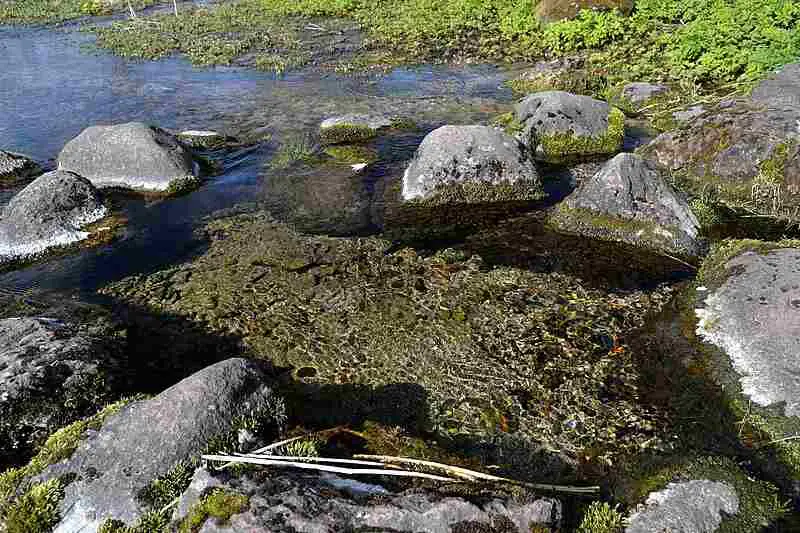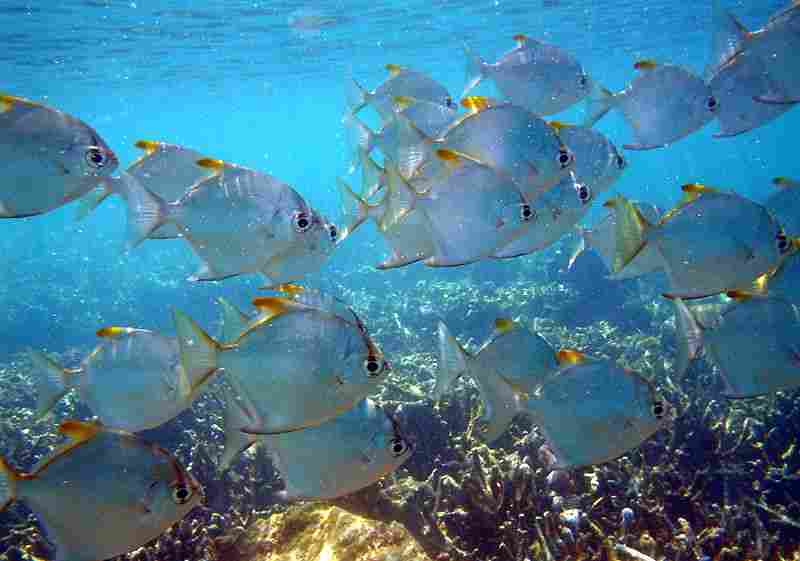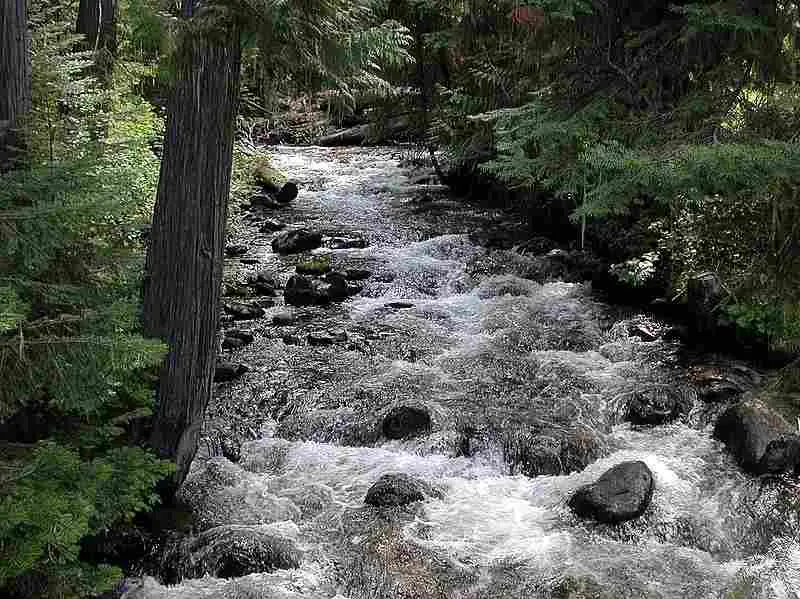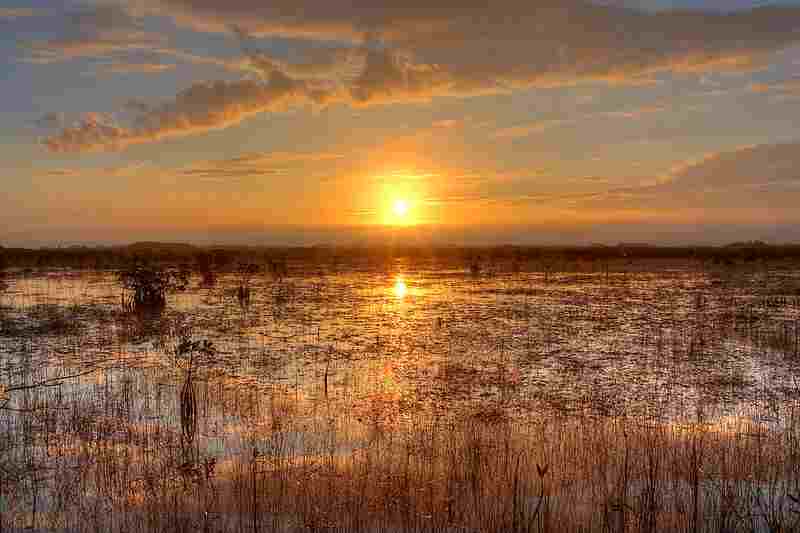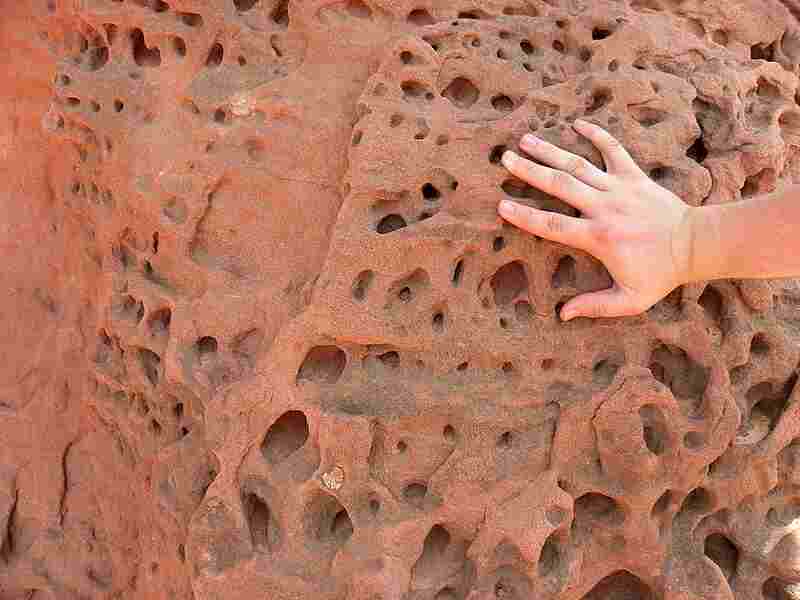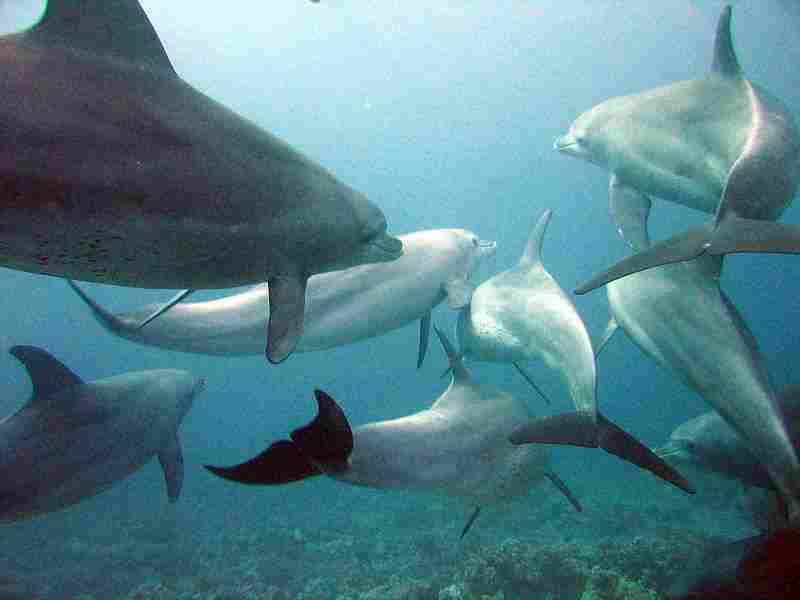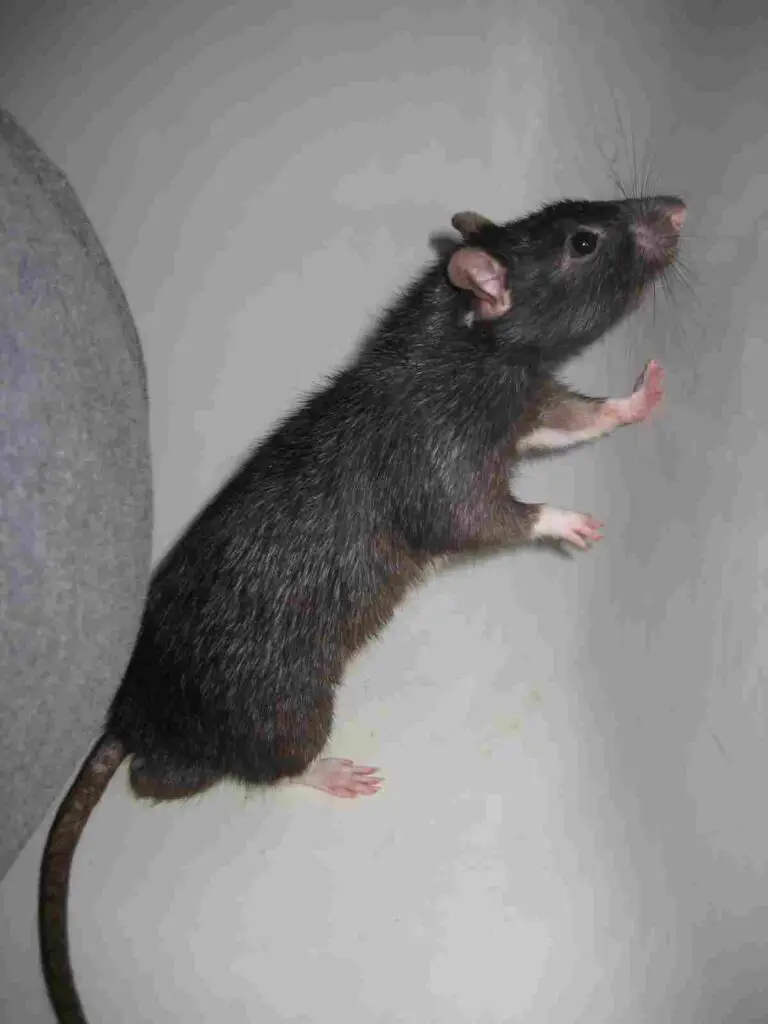9+ Abiotic Factors in a Pond Ecosystem and Their Importance
Abiotic factors in a pond are; sunlight, water, dissolved oxygen, nutrients, physicochemical parameters, sediments, rock substrate, suspended particles, basin morphology, and hydrological dynamics.
This article discusses abiotic factors in a pond ecosystem and their importance, as follows;
1). Sunlight (as one of the Abiotic Factors in a Pond Ecosystem)
Sunlight is arguably the most important of all abiotic factors in a pond, due to its multifaceted and vital role to the functioning, sustainability and success of this aquatic ecosystem.
This section discusses sunlight in terms of its ecological significance, as well as its link to biotic factors.
Importance of Sunlight in a Pond Ecosystem
The significance of sunlight in a pond ecosystem is hinged on its involvement in primary production, food web sustenance, oxygen production, temperature regulation, water quality control, species richness/population size, as well as regional seasonality.
Solar radiation in the form of visible light, serves as the primary energy resource for photosynthesis in pond autotrophs like algae and submerged macrophytes.
These aquatic primary producers all contain pigments like chlorophyll, which capture solar energy, and enable them to convert carbon dioxide and water into organic compounds/biomass (in the form of glucose), with oxygen as a byproduct. The process described forms the foundation of the aquatic food chain in ponds.

Photosynthetic organisms, energized by sunlight, occur at the base of the pond food web. These organisms are responsible for producing organic matter that serves as food for herbivores, such as some mollusks, crustacean-zooplankton, and small fish [6], thereby initiating the energy transfer process through the trophic levels.
Pond plants are indirectly responsible for the survival of predatory organisms in this ecosystem; which feed on lower organisms like the herbivores, thereby creating a complex trophic network of energy flow. In the absence of sunlight, the primary production function, by aquatic plants and algae would be severely inhibited, leading to an ultimate collapse of the food web.
As earlier stated; during photosynthesis, oxygen is released as a byproduct into the water, particularly in daylight hours. This event can be described as the basis of the aquatic oxygen cycle, and is essential for the respiration of aquatic organisms, including various species of fish, arthropods, and microorganisms. Adequate levels of dissolved oxygen are therefore crucial for the survival of most pond inhabitants.
Sunlight also has a role to play in regulating the instantaneous temperature of pond water. Solar electromagnetic radiation also contains infrared waves [5], which accompany light waves, and contain thermal energy that heats the surface layers of the pond during the day, to establish thermal stratification.
This temperature variation across the vertical profile of the water, affects the distribution and behavior of aquatic animals inhabiting the pond.
Excessive sunlight, especially in nutrient-rich tropical ponds, can lead to the growth of vast algal blooms. While some of these algae are beneficial as a food source, excessive algal growth can result in water turbidity (reduced clarity) due to suspended algae cells. Turbidity, in turn, can reduce the penetration of sunlight into the deeper layers of the pond, and inhibit primary productivity.
Overgrown algal masses can also cause oxygen depletion and pose a risk to the survival of heterotrophs in affected ponds.
As already explained, sunlight availability directly influences the rate of primary production, and the overall organic biomass of aquatic plants. Greater amounts of sunlight allow for increased plant growth, resulting in a more productive ecosystem with a larger and more diverse organic community.
Seasonality is a phenomenon that also impacts pond ecosystems, and which can be traced to the influence of factors like solar radiation.
This is because the relative angular orientation, and intensity of sunlight vary with the seasons, so that they influence the temporal behaviors and species composition of pond communities.
Seasonal changes in sunlight contribute to the timing of reproductive cycles, hibernation, and migration, among other processes of many pond organisms.
Diurnal variations in sunlight also affect the behaviors of aquatic organisms. Many species, such as fish and some zooplankton, may be more active, and forage during daylight hours when the pond is illuminated by solar rays.
2). Water in a Pond Ecosystem
Water is a fundamental abiotic component of a pond ecosystem, owing to its central role in establishing characteristics of this ecosystem, while supporting its inhabitants, and facilitating its ecological processes.
The Importance of Water in a Pond Ecosystem
The importance of water in a pond ecosystem is based on its roles in habitat provision, nutrient transport, oxygen dissolution, temperature regulation, plant growth, aesthetic attribution, and hydrological maintenance among others.
As the ambient medium, water in a pond provides a habitable zone for a wide variety of aquatic species, including different types of fish, crustaceans, amphibians, insects, and microorganisms. These organisms all possess unique adaptations to their aquatic environment.
Several species of arthropods and amphibians use pond water for breeding. This is because the stable water column of a pond provides a relatively safe environment for the development of eggs and larvae.

Water in a pond functions as a medium for the effective transport of nutrients that are essential for the growth of aquatic vascular plants, and algae. Nutrient cycling within the pond ecosystem is therefore facilitated by the mobility of water.
Pond water serves as a repository for dissolved oxygen, which is vital for the respiration of all aerobic-aquatic organisms. The gas is usually absorbed from the atmosphere, and released by aquatic plants during photosynthesis. Oxygen levels in the water column can vary with depth and temperature [18].
Because it has a relatively high specific heat capacity, water can absorb and retain thermal energy (heat) in significant amounts. This property helps in the stabilization of temperature fluctuations within a pond, thereby establishing a more suitable environment for aquatic life.
The biodegradation of organic matter that occurs in ponds, is affected by water which is also the encapsulating (ambient) medium in which this process occurs. Materials that decompose in ponds include leaves, remains of dead organisms, and granular organic detritus. Decomposers help break down this organic material, and release nutrients back into the water.
The boundaries of a pond are delineated by water, which distinguishes the water body from its surrounding terrestrial environment. The physical attributes of pond water, such as its depth and clarity, determine and influence the types of organisms that inhabit it.
The growth and buoyancy of submerged, emergent, and free-floating aquatic plants are supported by water. These plants contribute to the structure, composition and function of the pond ecosystem.
Hydrological processes govern water in ponds, including examples like evaporation and precipitation. These processes can control the concentration of dissolved substances, and the water level within the pond.
Water in a pond is a core element of its aesthetic value as part of natural landscapes; and also provides recreational opportunities such as fishing, birdwatching and boating.
Lastly, the water column is utilized by aquatic herbivores and predators as a resource-base for foraging, hunting, and refuge-seeking. The physical properties of water affect the behavior, ecological interactions, and biological success of these organisms.
3). Nutrients (as Abiotic Factors in a Pond Ecosystem)
Nutrients, such as nitrogen and phosphorus, are important abiotic components of a pond ecosystem.
This because they are pivotal role to the health, continuity and ecological performance of the aquatic biome as a whole. This section discusses the importance of nutrients in ponds.
Importance of Nutrients in a Pond Ecosystem
The importance of nutrients in a pond ecosystem ranges from autotroph nourishment to sustenance of trophic relationships, ecologic limitation (that is; nutrients as limiting factors), and water quality control.
Nutrients serve as critical building blocks in the growth of aquatic autotrophs, including algae, vascular and non-vascular plants.
Aquatic plants are primary producers of the pond ecosystem, and responsible for capturing and converting solar energy through photosynthesis. Also, nitrogen and phosphorus are essential components of the biochemical processes that drive photosynthesis [15].
These elements are incorporated into the cells of plants, and are essential for the synthesis of chlorophyll and various organic compounds.
As aquatic plants in ponds assimilate nutrients from the water, the nutrients are transferred through the food web in the process of feeding. Herbivorous animals directly consume plant material, while carnivores (and some omnivores) consume these herbivores, thereby establishing and sustaining trophic interactions in the pond ecosystem.
Availability of nutrients in ponds can serve as a limiting factor for phytoplankton growth [3]. A reduction in the levels of nitrogen and phosphorus can impact the productivity as well as diversity of aquatic communities, as they rely on these nutrients for growth/survival.
Excessive inputs of nutrients, particularly from urban-industrial and agricultural sources, can lead to eutrophication. This process leads to the overgrowth of algae and hydrophytic plants, and can disrupt the balance of the ecosystem.

Organic matter that occurs in (or enters into) ponds, such as plant leaves, and remains of dead organisms, contains nutrients. Decomposers break down such organic matter, thereby releasing nutrients back into the water, where they become accessible to support new growth. This implies that pond nutrients can be viewed as a link between abiotic and biotic factors in the ecosystem.
In general, nutrient levels need to be balanced within a pond in order to maintain water quality. Excessive and irregular amounts of nutrients can lead to water quality issues, such as algal blooms, decreased oxygen levels, and fouling, which affect the health of the ecosystem.
Through their various functions, nutrients contribute to the structural integrity of vegetation in aquatic ecosystems like ponds. Phosphorus, for instance, plays a role in root development and overall plant wellbeing.
Lastly, nutrient cycling ensures the sustainable functioning of the pond ecosystem. The movement of nutrients through the food chain/web and their recycling in the aquatic environment, contribute to long-term stability.
4). Physicochemical Parameters in a Pond Ecosystem
Physicochemical parameters are essential abiotic components of a pond ecosystem, which provide valuable insights into the physical and chemical characteristics/conditions of the aquatic environment.
These parameters have significant influence over the sustainability and health of the ecosystem, and are also crucial for understanding the conditions that are suitable for various forms of aquatic life.
The Importance of Physicochemical Parameters in a Pond Ecosystem
The importance of physicochemical parameters in a pond ecosystem can be attributed to their impacts and roles in organic metabolism, respiration, survival, water clarity and nutrient availability.
Examples of physicochemical parameters in ponds include temperature, pH, dissolved oxygen, total dissolved solids, alkalinity, oxygen demand, and nutrient concentration. They are discussed briefly below in terms of their importance.
Temperature affects the metabolic rates [14] of all major groups of aquatic organisms, including plants, animals, and microorganisms. It exerts influence over the rate of chemical reactions and the solubility of gases in water.
Monitoring temperature conditions, helps to assess the suitability of the pond habitat for different species, and can reveal seasonal variations that impact breeding and feeding patterns.
pH (Acidity/Alkalinity) levels are indicative the acidity or alkalinity of the water, and affect both chemical reactions and the availability of essential nutrients. Aquatic organisms have specific pH tolerances based on their adaptive evolution, so that the pH of any given pond habitat determines the organisms it can accommodate.
Maintenance of suitable pH levels is important for the survival of aquatic life, as extreme pH values can pose a threat to organic vitality and survival.
Dissolved Oxygen (DO) is a crucial parameter for the respiration of pond-dwelling aquatic organisms. It is influenced by factors like water movement, photosynthesizing organisms, and temperature.
Low DO levels can lead to hypoxia, which is potentially harmful to fish and other aerobic organisms. By monitoring DO, it is possible to effectively assess water quality and the potential for supporting aquatic life.
Total Dissolved Solids (TDS), and turbidity are closely-related physicochemical variables that indicate the presence of dissolved and suspended (particulate) materials in water. TDS can include organic matter and mineral salts, while turbidity estimates water clarity, especially with regards to the presence of soluble and insoluble suspended materials.
High TDS levels can negatively impact water quality and the suitability of the aquatic habitat for living organisms. Turbidity can affect light penetration, which is an essential factor for photosynthesis in aquatic autotrophs.
Total alkalinity and hardness are both related to the presence of minerals, primarily magnesium and calcium ions [16], which may buffer against pH fluctuations.
Stable alkalinity and hardness conditions are essential for preventing excessive pH fluctuations that can be harmful to aquatic organisms.
Chemical Oxygen Demand (COD) and Biochemical Oxygen Demand (BOD), measure the demand for oxygen, of organic and inorganic matter in water. High levels of these parameters are indicative of pollution.
Monitoring COD and BOD is helpful to evaluate water pollution occurrence/levels and the potential harm which this poses to aquatic life.
Nutrient concentrations especially for essential elements like nitrogen, play a key role in determining the growth of aquatic autotrophs. Excessively high concentrations of nutrients can lead to eutrophication.
Nutrient-related degradation can be detected and mitigated through monitoring of nutrient concentrations, thereby preventing the disruption of ecological balance of the pond.
Water transparency is another physicochemical variable that is sometimes put into consideration. It measures the maximum depth to which light can penetrate, and impacts both the distribution of aquatic plants and the growth of algae.
Understanding transparency of the water column in any pond, helps to assess the potential for photosynthesis and productivity in the aquatic ecosystem.
5). Sediments (as one of the Abiotic Factors in a Pond Ecosystem)
Sediments are an often-overlooked but critically important, abiotic component of pond ecosystems.
They comprise of particles of earth materials that tend to settle at the bottom of the pond, to form a substrate comprising of detrital organic matter, minerals, and microbial inhabitants.
The Importance of Sediments in a Pond Ecosystem
Sediments in a pond ecosystem are important for their roles and involvement in nutrient cycling, microbe habitat-provision, water filtration and detoxification, nutrient exchange/buffering, and carbon sequestration.
Pond sediments are repositories for macro and micronutrients including phosphorus and nitrogen [7]. These nutrients are essential for autotroph growth, and can originate from runoff, aquatic-organic waste, and decaying organic matter.
Sediments release their stored nutrients gradually into the water column. This is the basis of aquatic nutrient recycling, and is essential for supporting the growth of aquatic plants and phytoplankton, which constitute the basal level of the pond's food chain.
Pond sediments usually provide a habitat for a diverse community of macrobial invertebrates, as well as microorganisms. Examples of these include bacteria, fungi, worms and insect larvae, that live in or on the sediments.
These organisms contribute to nutrient cycling, by breaking down organic biomass and detritus. They also contribute to the overall pond ecosystem by serving as a food source for organisms in higher trophic levels.
Sediments can act as natural filters, that trap and immobilize pollutants like heavy metals and excess elemental nutrients.
This detoxification mechanism helps to maintain water quality in ponds by preventing harmful substances from persisting in the water column. It contributes to the overall functionality of the pond and the wellbeing of its inhabitants, by mitigating pollution.
Certain aquatic species, such as crayfish and some species of fish, rely on pond sediments as shelter and site of reproduction. They create burrows and nests within these sediment.
These burrowing species are an integral part of the pond habitat. Their activities and behaviors provide habitat and refuge for both themselves and other organisms, thereby enhancing biodiversity.
Sediments can interact with the pond-water column, with which they exchange nutrients and other ions. They can also act as a buffer that helps to stabilize water pH and prevent extreme fluctuating conditions.
This combination of nutrient exchange and buffering capacity, contributes to the overall stability of the pond ecosystem. It ensures that essential nutrients remain available and accessible to aquatic life.
Organic matter (detritus, plant and animal remains) contained within pond sediments, is a medium of carbon storage.
Carbon storage in sediments can help to mitigate the local effects of climate change, by sequestering carbon dioxide (a greenhouse gas) from the atmosphere. It also contributes to the sustenance of the carbon cycle in aquatic ecosystems.
6). Rock Substrate in a Pond Ecosystem
Rock substrate, which is often found at the bottom and along the edges of ponds, is an important abiotic component of pond ecosystems.
While it is less prominent than some other abiotic factors, rock substrate is responsible for several vital roles that support the development and continuity of a healthy and well-balanced pond ecosystem.
The Importance of Rock Substrate in a Pond Ecosystem
Rock substrate in a pond ecosystem is important as a habitat for beneficial bacteria, a site of algal growth, primary production, organic sheltering, water filtration and erosion control.
Rocks in a pond provide a solid surface for beneficial bacteria to colonize. These bacteria are essential for biological filtration and the breakdown of organic matter.
Beneficial bacteria on pond-rock substrate; help convert harmful substances like nitrites and ammonia, from fish waste and other forms of decaying organic matter, into less toxic compounds, through the oxidative process of nitrification [4]. This function is crucial for maintaining water quality and overall health of aquatic life.
Algae, including sole-colonizing microalgae and algae in periphyton, can attach themselves to rock surfaces. These organisms are primary producers, which utilize sunlight for photosynthesis.
They constitute the base of the pond food web, by converting sunlight and nutrients into organic matter. Algae also provide food for herbivorous organisms, and oxygen for the entire pond ecosystem through photosynthesis.

The spaces and crevices between rocks, create sheltered areas which offer protection for various aquatic organisms. Some species use these crevices for spawning or as refuge from predators. While such a scenario is most common in marine ecosystems and other large water bodies, it also occurs in some ponds.
Shelter is an essential resource for the reproduction and survival of many aquatic species, including fish, amphibians, and various invertebrates. It promotes biodiversity in the pond ecosystem by creating suitable niches for different life stages.
Rocks may contribute to water mobilization, circulation and aeration within the pond. This is because water flows around and over the rocks, becoming oxygenated in the process.
Proper water circulation ensures that oxygen is distributed evenly throughout the pond, to the benefit of all aquatic organisms. In addition, it helps remove excess carbon dioxide and other gases from the water, thereby mitigating the prospect of acidification.
Rocks add to the aesthetic value of the pond ecosystem, creating a more visually appealing environment. They can also contribute to the formation of a transition zone between terrestrial and aquatic habitats.
Localized erosion can be mitigated by rocks along the edge of ponds, which help to prevent erosion by adding to the mechanical stability of the shoreline. These rocks can absorb wave energy and protect against sediment runoff, during and after storm events.
Control of erosion is essential for maintaining water clarity, preventing sedimentation, and preserving the productivity of pond ecosystems. It protects water quality and prevents disturbances that can affect organic inhabitants of ponds.
7). Underwater Topography (as one of the Abiotic Factors in a Pond Ecosystem)
Underwater topography refers to the spatial configuration including slope and elevation of the pond's bottom and its surrounding land; and can be considered a critical abiotic component of pond ecosystems.
The Importance of Underwater Topography in a Pond Ecosystem
Underwater topography of a pond is important, for its roles in establishing and supporting habitat diversity, shelter and spawning grounds, thermoregulation, water circulation, and organic nutrition.
The underwater topography of a pond is usually diverse, and features areas of different slopes, depths, and substrates. This diversity results in a range of habitats that support various aquatic organisms, from shallow and sunlit areas to deeper and shaded regions.
Different species of aquatic plants and animals prefer specific habitat types/conditions [9], and this preferential trend leads significant biodiversity within the pond.
Variations in underwater topography provide shelter, hiding spots, and suitable micro-environmental conditions for nesting and spawning. The growth of submerged vegetation is dependent on topographic conditions, and may offer protection and feeding grounds for fish and various invertebrates. Rocky or sandy areas may also serve as spawning sites for some species.
The depth and topography of a pond both influence its thermal stratification. In general, the deeper areas tend to have cooler water, while shallow regions tend to warm up more quickly.
This condition of thermal variability is essential for aquatic organisms, as it enables them to select water temperature zones that suit their needs/adaptations. It also affects the distribution of essential resources like oxygen, as temperature impacts the oxygen-holding capacity of water [12].
Water circulation in ponds is also affected by the underwater topography. Submerged features such as rock substrates and inclines can affect water movement, causing laminar currents and eddies. This circulation can help oxygenate the water, disperse organic resources, and distribute nutrients. It also prevents stagnation of the water column, which can lead to degradation of water quality.
Variation in topography within the pond ecosystem, creates areas with different sedimentation conditions and water flow patterns. This influences the distribution of small macrobial invertebrates, and microorganisms, which may serve as food for other pond residents like fish. Foraging species take advantage of these variations to find prey in concentrated spots.
The underwater topography of a pond can affect its nutrient cycling and sediment deposition trends. Nutrients such as nitrogen and phosphorus, may accumulate in specific areas on the basis of water movement and topographic features. These nutrient-rich zones are helpful in supporting the growth of aquatic plants, thereby impacting primary production and sustaining the entire food web.
Studying and Measuring Underwater Topography in Pond Ecosystems
Understanding underwater topography is a crucial step for habitat management and conservation with regards to pond ecosystems.
Studying and measuring underwater topography involves methods and tools like; bathymetric survey, remote sensing, GIS utilization, and water quality monitoring.
Bathymetry is similar to topographic analysis on land, in that it involves measuring the depth and morphology of underwater terrain [11]. Bathymetric surveys are carried out using specialized equipment like echo sounders to create detailed depth maps of ponds. These maps are studied to understand the contours and features of the pond bottom. It must be noted that such technological implementation is most common in ocean exploration.

Aerial photography and satellite imagery can provide valuable insights into the surface characteristics of the pond and its surrounding landscape. Remote sensing technologies can detect temporal changes in the conditions and attributed of submerged vegetation and shorelines.
GIS (Geographic Information Systems) software can be utilized to create digital maps that incorporate topographic and bathymetric data. These maps enable researchers and conservationists to effectively analyze the relationships between underwater topography and different ecological variables.
Lastly, the continuous monitoring of water temperature, dissolved oxygen, and other physicochemical parameters can reveal how topography influences the conditions of pond environments. Variations in these parameters can often be linked to changes in topography.
8). Suspended Particles in a Pond Ecosystem
Suspended particles in a pond ecosystem can also be referred to as total suspended solids (TSS), and constitute a critical abiotic component with several ecological implications.
The Importance of Suspended Particles in a Pond Ecosystem
The importance of suspended particles in a pond ecosystem range from their roles in water clarity control and nutrient transport, to their involvement in sedimentation, water quality variation, and habitat alteration.
Water clarity is significantly influenced by suspended particles, which may determine how much sunlight penetrates the water column. Sunlight penetration, in turn, influences the growth of algae and aquatic plants.
Clear water permits more light to reach submerged vegetation, thereby increasing the productivity of photosynthesis. On the other hand, high TSS can reduce light penetration, and may inhibit plant growth [2].
Suspended particles in ponds can act as carriers for essential nutrients. These nutrients may be either attached to or contained in fine particles, which transport them through the water. When particles settle, they deposit their nutrient contents in specific areas, and potentially influence primary production within these zones.
Sedimentation is facilitated by suspended particles that settle and accumulate at the bottom of the pond. Over extended periods of time, this sediment buildup can cause changes to the pond's topography, thereby affecting habitat depth and diversity.
High concentrations of suspended particles can have a negative impact on water quality. The particles can significantly reduce water clarity and make it difficult for aquatic organisms to find food and reproduce. In addition, suspended particles can clog the gills and feeding structures of some filter-feeding organisms, impairing their functions [1].
The settling of suspended particles can create some distinct microhabitats on the pond bottom. For instance, the accumulation of organic matter and silt can lead to the formation of small-scale mud flats, which are important for accommodating certain species of amphibians and invertebrates.
Total Suspended Solids (TSS) in Pond Water
Total suspended solids (TSS) are particles that are larger than 1 micron in diameter, occurring in the water column.
These particles can comprise of various materials, including clay, silt, organic matter, bacteria, algae cells, and detritus. High TSS levels can be indicative of poor water quality, and may affect the ecological balance of a pond.
Removing Suspended Clay from Pond Water
Removing suspended clay from pond water can be achieved using various methods and treatments, including; flocculant application, vegetation stabilization, erosion control, and mechanical extraction.
Some chemical flocculants can be added to pond water in order to promote the aggregation of suspended particles. These chemicals generally cause the particles to clump together, and make them easier to settle. An example of such flocculant is gypsum (hydrated calcium sulfate), often used along with unmodified peptides, which can attract or coagulate clay particles and facilitate their settling [17].
Planting aquatic vegetation can be helpful to stabilize pond bottoms and reduce the rate of clay particle resuspension. The roots of these aquatic plants, bind soil particles and prevent them from becoming suspended in the water column.
Implementation of erosion control measures around the watershed areas of ponds, can help minimize localized soil erosion, which is a primary source of suspended particles. Strategies may include the use of vegetative buffers, silt fences, and sediment basins.
In some cases, mechanical methods, such as sediment dredging or largescale settling, can be employed in order to physically remove accumulated sedimentary particles from the pond.
9). Basin Morphology (as one of the Abiotic Factors in a Pond Ecosystem)
Basin morphology is to the sum total of physical characteristics and dimensions of a pond's watershed or basin area.
These dimensions significantly influence the conditions of the pond's water column, as well as the species that inhabit it.
Implications of Basin Morphology in a Pond Ecosystem, for Water Conditions and Inhabitants
The implications of basin morphology in a pond ecosystem can be observed and evaluated in terms of; hydrology and water circulation, nutrient loading, sedimentation, habitat diversity, temperature regulation, oxygen concentration, biodiversity, management and conservation.
Basin morphology influences the hydrological conditions of a pond. The shape, size, and slope of the basin collectively determine how water flows into and out of the pond.
Ponds that have large and steep basins tend to receive a substantial influx of water during rainfall events, potentially resulting in increased water flow, nutrient input, and sediment transport.
On the other hand, smaller and gently sloping basins may have more stable water levels.
Characteristics of the watershed including local land use and vegetation cover, can influence the amount of nutrients that enter into the pond.
Adjacent agricultural or urban areas with high nutrient runoff can lead to eutrophication, where excessive nutrients (such as phosphorus, potassium and nitrogen) in the water column can promote largescale algal blooms and oxygen depletion [10]. For such scenarios, basin morphology often plays a role in determining the extent of nutrient loading.
The shape and size of the basin can affect rates of sedimentation within a pond. Steep basins may be associated with increased sediment runoff, which typically leads to greater sediment deposition in the pond. Accumulated sediments can alter the depth of ponds, while impacting water clarity, and creating multiple microhabitats on the pond bottom.
This implies that basin morphology is related to the diversity of habitats found within any given pond ecosystem. Ponds that have complex basins with diver shallow and deep areas, as well as rocky outcrops and submerged vegetation, offer a broader range of habitats for various aquatic species. Such habitats can support different life stages and activities of the organisms, such as larval development, overall breeding, and foraging.
The orientation and depth of the basin can affect water temperature. Shallow basins may experience more significant temperature fluctuations owing to their limited water volume, while deep basins are likely to provide more-stable temperature conditions. Temperature gradients within the water column influence the distribution and adaptation of aquatic organisms.
Basin morphology also influences the distribution of oxygen within the pond. Deeper basins may have well-stratified layers with varying oxygen concentrations. Understanding these patterns of stratification is important for managing the health of fish populations, since some species are tolerant of specific oxygen levels.
The combination of basin morphology, microhabitat diversity and water conditions, determines the biodiversity of a pond. Ponds that have diverse basin characteristics can support a wide array of species, including fish, amphibians, aquatic plants and invertebrates,.
Lastly, assessments of basin morphology are essential for pond management and conservation efforts. Understanding the interaction between a pond's physical characteristics and its ecological processes, helps to inform strategies for mitigating nutrient loading, controlling sedimentation, and maintaining or enhancing biodiversity.
10). Hydrological Dynamics in a Pond Ecosystem
Hydrological dynamics in a pond ecosystem are concerned with the trends of movement and circulation of water, within the pond.
These flow trends and conditions are essential abiotic factors that affect various aspects of the pond's hydrology and ecology.
Importance of Hydrological Dynamics in a Pond Ecosystem
The importance of hydrological dynamics in a pond ecosystem includes their involvement in oxygenation, nutrient distribution, temperature regulation, sediment resuspension, habitat diversification, and detoxification.
Hydrological dynamics, primarily in form of water movement, are involved in oxygenating the pond. As already discussed earlier in this article, oxygen is essential for the survival of aquatic organisms, including autotrophs and heterotrophs. Adequate water movement ensures that oxygen is effectively distributed to support these organisms throughout the water column.
Water movement helps in the distribution of nutrients within the pond, many of which are essential for the growth of aquatic plants.
Proper circulation ensures that such nutrients are available to support primary producers at various depths, thereby contributing to a healthy and productive ecosystem.
Flow conditions can also influence water temperature [13]. Mixing of different water layers in the process of circulation, helps to regulate temperature gradients that occur within the pond. This is an important function because temperature affects the metabolic rates of aquatic organisms, and the trend of seasonality in the pond.
Hydrological dynamics can resuspend sediments that have accumulated on the pond bottom. This process is essential in some cases, as it can prevent the accumulation of excessive bottom sediment, which can smother benthic habitats. It also helps release to nutrients trapped in the bottom sediments.
Water movement contributes to the diversity of microhabitats within the pond, by delineating areas with faster or slower flow, as well as zones of turbulence or calmer conditions. These spatial variations in flow create different niches for aquatic organisms, and contribute to overall biodiversity.
Lastly, flow conditions can enhance (or inhibit) the dilution or removal of pollutants from the water. Adequate circulation can facilitate the de-concentration and breakdown of harmful substances, thereby improving pond water quality.
How Water Moves in a Pond
Water movement in a pond can occur through various mechanisms, such as wind action, thermocline formation, inlet and outlet flow.
Wind can facilitate surface water movement, which leads to mixing and surface rippling. However, this primarily affects the upper layers of water in ponds.
In significantly deep ponds, temperature gradients can contribute to the formation of thermoclines, which are layers of water with different temperatures and densities [8]. Mixing may occur at the boundaries between these layers.
Lastly, ponds often have inflows and outflows, which can facilitate directional water movement. This can be helpful with water exchange and nutrient transport.
Hydrological Processes in a Watershed
Hydrological processes in a watershed include mechanisms like precipitation, interception, evaporation, infiltration, surface runoff, and groundwater flow, that control the movement and distribution of water across the landscape. These processes/mechanisms are briefly outlined below;
Precipitation involves the input of water into watersheds in the form of rain or snow.
Interception is the process whereby vegetation intercepts and temporarily stores precipitation.
Evaporation has to do with the conversion of liquid water into water vapor.
Infiltration is the movement of water (from the watershed area) into the ground.
Surface runoff is the flow of water over the land surface, often into streams or ponds.
Groundwater flow is the movement of water through underground aquifers.
The study, understanding and evaluation of these processes is important for managing watersheds, because they influence the quality and quantity of water that eventually reaches ponds and other aquatic ecosystems.
Conclusion
Abiotic factors in a pond are;
1. Sunlight
2. Water
3. Dissolved Oxygen
4. Nutrients
5. Physicochemical Parameters
6. Sediments
7. Rock Substrate
8. Suspended Particles
9. Basin Morphology
10. Hydrological Dynamics
References
1). Bilotta, G. S.; Brazier, R. E. (2008). "Understanding the influence of suspended solids on water quality and aquatic biota." Water Res. 2008 Jun;42(12):2849-61. Available at: https://doi.org/10.1016/j.watres.2008.03.018. (Accessed 7 September 2023).
2). Buana, S.; Tambaru, R.; Selamat, M. B.; Lanuru, M.; Massinai, A. (2021). "The role of salinity and Total Suspended Solids (TSS) to abundance and structure of phytoplankton communities in estuary Saddang Pinrang." IOP Conference Series Earth and Environmental Science 860(1):012081. Available at: https://doi.org/10.1088/1755-1315/860/1/012081. (Accessed 7 September 2023).
3). Caraco, N.; Tamse, A.; Boutros, O.; Valiela, I. (2011). "Nutrient Limitation of Phytoplankton Growth in Brackish Coastal Ponds." Canadian Journal of Fisheries and Aquatic Sciences 44(2):473-476. Available at: https://doi.org/10.1139/f87-056. (Accessed 7 September 2023).
4). Daims, H.; Lücker, S.; Wagner, M. (2016). "A New Perspective on Microbes Formerly Known as Nitrite-Oxidizing Bacteria." Trends Microbiol. 2016 Sep;24(9):699-712. Available at: https://doi.org/10.1016/j.tim.2016.05.004. (Accessed 7 September 2023).
5). Fontenia, J. M.; Harder; Livingston; Snow, M.; Woods, T. N. (2011). "High-resolution solar spectral irradiance from extreme ultraviolet to far infrared." Journal of Geophysical Research Atmospheres 116(D20):D20108. Available at: https://doi.org/10.1029/2011JD016032. (Accessed 7 September 2023).
6). Getachew, T. (1987). "A study on an herbivorous fish, Oreochromis niloticus L., diet and its quality in two Ethiopian Rift Valley lakes, Awasa and Zwai." Journal of Fish Biology 30(4):439 - 449. Available at: https://doi.org/10.1111/j.1095-8649.1987.tb05767.x. (Accessed 7 September 2023).
7). Islam, A.; Jahan, N.; Quadir, Q. F.; Haque, S. M. (2020). "Assessment of fish pond sediments for growth, yield and nutritional quality of Indian spinach (Basella alba L.)." Archives of Agriculture and Environmental Science 5(1):33-39. Available at: https://doi.org/10.26832/24566632.2020.050105. (Accessed 7 September 2023).
8). Lai, Y.; Yang, J. (2022). "Thermocline Depth on Water-rich Exoplanets." Available at: https://iopscience.iop.org/article/10.3847/1538-4357/ac7221. (Accessed 7 September 2023).
9). Mullu, D. (2016). "A Review on the Effect of Habitat Fragmentation on Ecosystem." Available at: https://www.researchgate.net/publication/322235107_A_Review_on_the_Effect_of_Habitat_Fragmentation_on_Ecosystem. (Accessed 7 September 2023).
10). Nyenje, P. M., Foppen, J. W.; Uhlenbrook, S.; Kulabako, R.; Muwanga, A. (2010). "Eutrophication and nutrient release in urban areas of sub-Saharan Africa--a review." Sci Total Environ. 2010 Jan 1;408(3):447-55. Available at: https://doi.org/10.1016/j.scitotenv.2009.10.020. (Accessed 7 September 2023).
11). Okolie, C. J.; Olayinka-Dosunmu, D. N. (2018). "Satellite-Derived Bathymetry Modelling in Shallow Water: A Case Study of Lighthouse Creek, Lagos." Available at: https://www.researchgate.net/publication/327816511_Satellite-Derived_Bathymetry_Modelling_in_Shallow_Water_A_Case_Study_of_Lighthouse_Creek_Lagos. (Accessed 7 September 2023).
12). Rajwa-Kuligiewicz, A.; Bialik, R. J.; Rowiński, P. M. (2015). "Dissolved oxygen and water temperature dynamics in lowland rivers over various timescales." Journal of Hydrology and Hydromechanics 63(4):353 - 363. Available at: https://doi.org/10.1515/johh-2015-0041. (Accessed 7 September 2023).
13). Sinokrot, B. A.; Gulliver, J. S. (2000). "In-Stream Flow Impact on River Water Temperatures." Journal of Hydraulic Research 38(5):339-349. Available at: https://doi.org/10.1080/00221680009498315. (Accessed 7 September 2023).
14). Turker, H. (2011). "The Effect of Water Temperature on Standard and Routine Metabolic Rate in Two Different Sizes of Nile Tilapia [1]." Kafkas Universitesi Veteriner Fakultesi Dergisi 17(4):575-580. Available at: https://www.semanticscholar.org/paper/The-Effect-of-Water-Temperature-on-Standard-and-in-Turker/4af76b9e8424840987ef750323453bf13570d686. (Accessed 7 September 2023).
15). Wang, J.; Wen, X.; Zhang, X.; Li, S.; Zhang, D. Y. (2018). "Co-regulation of photosynthetic capacity by nitrogen, phosphorus and magnesium in a subtropical Karst forest in China." Sci Rep. 2018 May 9;8(1):7406. Available at: https://doi.org/10.1038/s41598-018-25839-1. (Accessed 7 September 2023).
16). Wurts, W. A. (2002). "Alkalinity and Hardness in Production Ponds." World Aquaculture 33(1):16-17. Available at: https://www.researchgate.net/publication/267245176_Alkalinity_and_Hardness_in_Production_Ponds. (Accessed 7 September 2023).
17). Yuzik, J.; Khatri, V.; Chae, M.; Mussone, P.; Bressler, D. C. (2021). "Ruminant-Waste Protein Hydrolysates and Their Derivatives as a Bio-Flocculant for Oil Sands Tailing Management." Polymers (Basel). 2021 Oct 14;13(20):3533. Available at: https://doi.org/10.3390/polym13203533. (Accessed 7 September 2023).
18). Zaker, N. H. (2007). "Characteristics and Seasonal Variations of Dissolved Oxygen." International Journal of Environmental Research 1(4). Available at: https://ijer.ut.ac.ir/article_140.html. (Accessed 7 September 2023).
